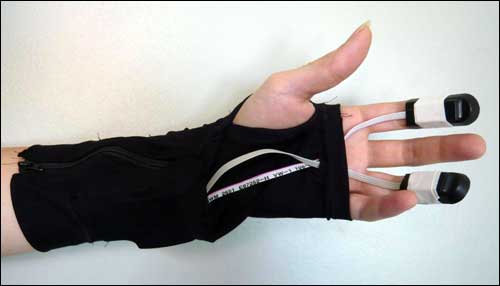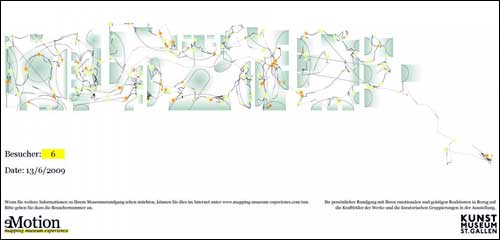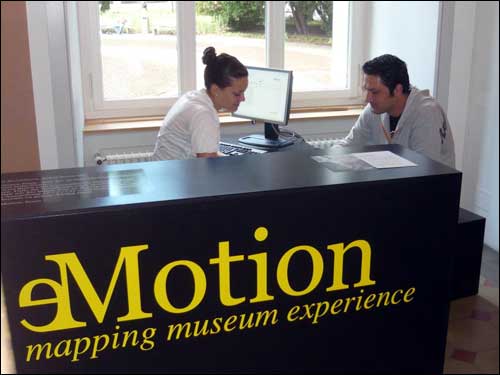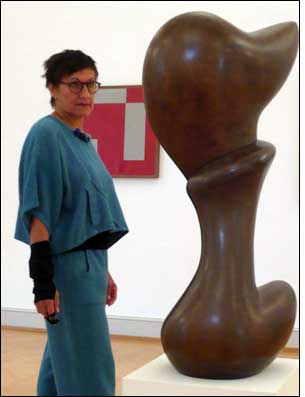Though millions of people walk the halls of art museums worldwide, exhibit curators often have little insight into how visitors experience the artwork on display. At a Swiss art museum filled with paintings and sculptures by Monet, Renoir, Klee and other renowned artists, a recently concluded experiment paired RFID location-sensing technology with wireless biometric sensors to determine how museum visitors emotionally responded to the artwork.
The goal of the experiment, entitled “eMotion: Mapping Museum Experience,” was to see how “the perception of ‘art’ can be measured.” A multidisciplinary team of researchers from the Institute for Research in Art and Design and the University of Applied Science Northwestern Switzerland spent five weeks observing the reactions of visitors to a special exhibit at the Kunstmuseum St. Gallen, located in eastern Switzerland.
“We approached various Swiss museums, and many were very unsure about our project However, St. Gallen was open to it,” says Steven Greenwood, an artist and programmer who served as the project’s technical manager. “St. Gallen created a classic 20th-century exhibition for us that covered many of the questions that the scientists and art experts were interested in.”
Visitors who volunteered to take part in the experiment, which ended in July of this year, were outfitted with a special glove containing a Ubisense active ultra-wideband (UWB) RFID tag that broadcasted the wearer’s location four times per second via a 6-8.5 GHz RF signal. Each glove also contained sensors that tracked the electrical conductivity of the wearer’s skin, as well as that person’s pulse. The electrical conductivity information was used as a proxy measure for cognitive stimulation, while the heart-rate data served as an indicator of emotional excitement.

The RFID tags transmitted the location data to Ubisense Series 7000 RFID readers, then forwarded that information to Ubisense’s Location Platform, which has standard application programming interfaces (APIs) that can export the data to other applications. The biometric data was transmitted via wireless LAN to a MySQL database, where it was merged with the location information. The location data was then used to determine which specific artworks the visitor had been viewing, and how long that individual had looked at each piece. By pairing the location and biometric data, the researchers could measure a participant’s biological and cognitive reaction to each work of art.
Before entering the exhibit, the visitors were asked a series of questions, such as their age and nationality, whether they had heard of the research project and their level of interest in art. In order to calibrate the biometric sensors, the volunteers were also asked questions such as whether they smoke cigarettes or recently drank a cup of coffee.
The visitors then made their way through the exhibit. Once they reached the end, they were offered the chance to view a computer screen displaying their tracks through the museum. That location data, merged with the biometric data. showed the visitors which artworks provoked cognitive or emotional responses. Each museum patron was then asked whether the recorded response matched his or her impression of how he or she responded.
“The idea was to promote self-reflection,” Greenwood explains. “Mostly, what we saw was a mixture of confirmation that the response was right, with some surprise by people who didn’t think they had responded to a piece of art.”

Click here to view a larger version of the photo.
Greenwood also turned the location-tracking data into illustrations that showed how certain works of art gathered more attention than others, thus exhibiting a kind of “aura” when seen through the prism of location data. On the illustrations, works of art that received greater attention show a more intense color than those that visitors quickly strolled by.
In order to test various hypotheses regarding how visitors make their way through museums, as well as how different pieces of art “interact” with one another in the visitor’s mind, the researchers regularly changed the exhibition’s contents and layouts. Though formal findings are not yet available, Greenwood says some initial observations were already quite clear.
“More educated and elderly visitors had much more interest in the so-called classical works of art, whereas it was the opposite pattern for younger visitors, who tended to be more stimulated by newer, more abstract works,” Greenwood explains. One particular piece of art, he says—which was covered with four-inch nails—was one of the few pieces that received an almost universal emotional response from the exhibit’s visitors.
The entire ground floor of the museum was outfitted with 20 Ubisense Series 7000 readers. One challenge involved installing these devices, which Ubisense refers to as sensors, according to Terry Phebey, the company’s VP of sales, who worked on the project.
“Old museums have big, thick walls, which means you won’t be able to get low-powered radio to go through them,” Phebey states. “That meant we had to have more sensors up than you would have had in a factory setting.”
The researchers say they chose the Ubisense RFID solution because of the accuracy it provided. “I spent six months looking at various location-tracking technologies—RFID, wireless LAN, video-tracking and so on,” Greenwood says. “And they all had their advantages and disadvantages. But the critical point for us was to cover the museum space with an accuracy of plus or minus 10 centimeters [4 inches], which only Ubisense could offer.”
The Swiss National Science Foundation funded the experiment, and Ubisense donated its technology. Phebey estimates the equipment and installation would have cost €60,000 to €70,000 ($86,000 to $100,000), with the location tags in the glove priced at €65 ($93) apiece.
Greenwood says his research team and the St. Gallen museum have already fielded calls from museums around the world looking to learn more about the experiment and potential applications. According to Phebey, museums—which number in the dozens in most cities, he says—may become a large market for location-sensing RFID technology.
Referring to the proliferation of small digital audio guides in museums, Phebey says his company regularly fields inquiries from museums regarding how to enhance the visitor experience. “The idea here,” he states, “is that with no interaction from the visitors—that just by walking through the museum and having the location picked up—that something would come up on a display panel, or they’d get some context-dependent information based on where they are.”
Ubisense has not yet sold such an application, however—in part, Phebey says, because the expense remains too high for museums. “But it’s just a matter of time,” he notes. “The cost of the tags and the sensors is always going down. At some point, we’ll hit a price point where museums feel they can jump in.”



